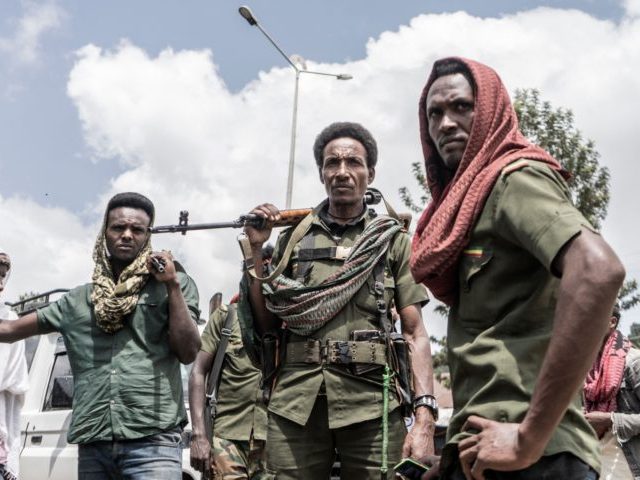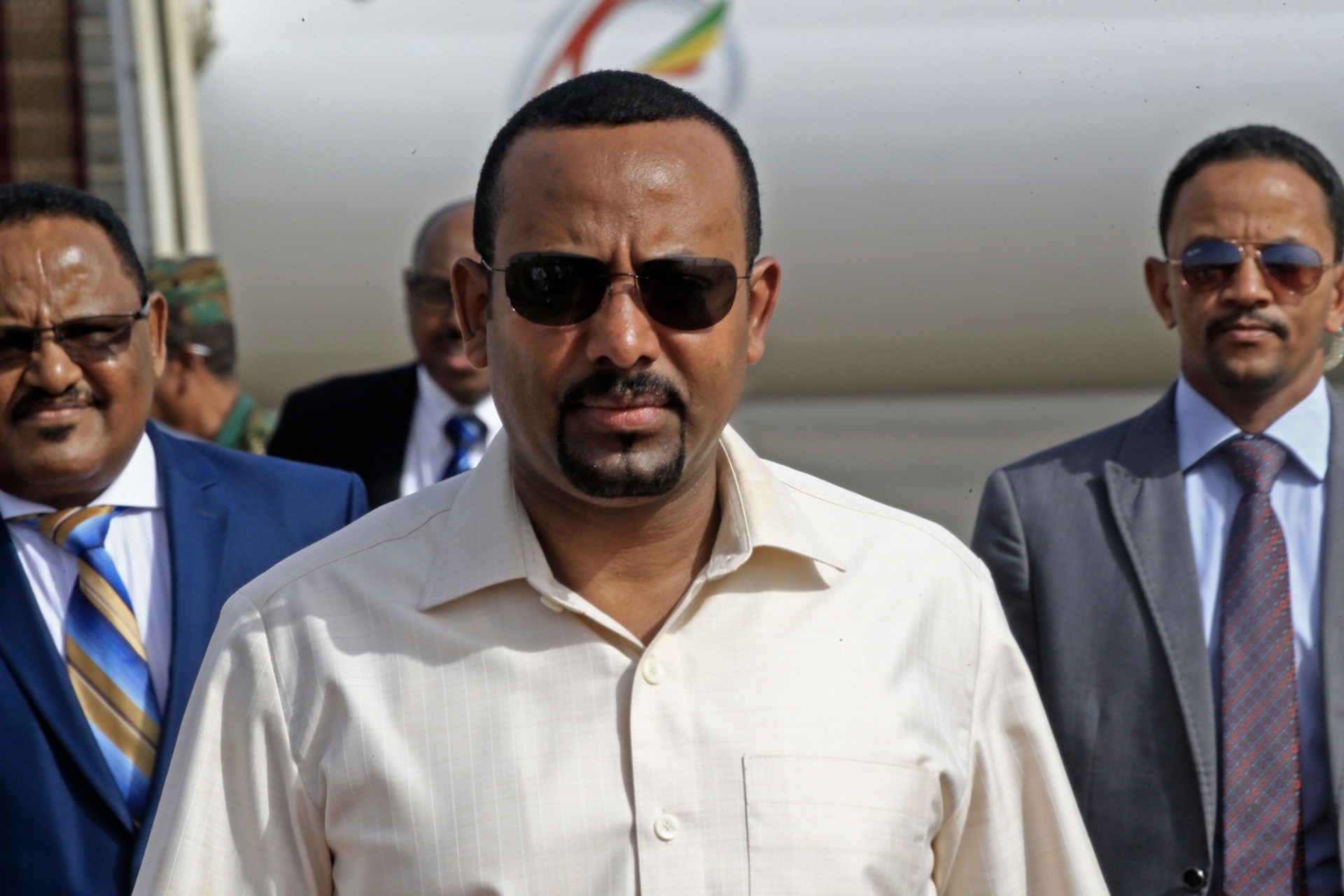Human Rights Watch (HRW) published a report on Thursday accusing Eritrean troops and Tigrayan militia of raping and killing Eritrean refugees living in northern Ethiopia.
Tigray is a restless province of Ethiopia that launched an increasingly unpleasant revolt against the central government in September 2020, when it held local elections deemed unlawful by the administration of Prime Minister Abiy Ahmed. Matters soon escalated to violence, including allegations of atrocities on all sides, accompanied by sickness, starvation, riots, and a refugee crisis.

Recruits for reserves of Amhara regional forces, together with members of the Amhara militia, celebrate during their graduation ceremony, in the city of Dessie, Ethiopia, on August 24, 2021. (EDUARDO SOTERAS/AFP via Getty Images).
The Ethiopian crisis has significant international ramifications — and international media is noticeably uncomfortable discussing it — because Prime Minister Abiy is a Nobel Peace Prize laureate, but now stands accused of inflicting massive civilian casualties in the civil war. Nobel Peace Prize winners are not supposed to drop bombs on civilians, use starvation as a weapon, urge vigilante militias to take up arms against rival ethnic groups, or shoot at United Nations staffers when they attempt to access conflict zones.
On the other hand, the director of the World Health Organization (W.H.O.), Dr. Tedros Adhanom Ghebreyesus, is Tigrayan and has been accused of aiding the rebels, a charge he denies.
During his career in Ethiopian government, Tedros was a member of the militant Marxist Tigrayan People’s Liberation Front (TPLF), which was the most powerful political entity in Ethiopia before Abiy came to office, and remains the primary Tigrayan fighting force. Officials from the central government claim his membership has not lapsed.

World Health Organization (WHO) Director-General Tedros Adhanom Ghebreyesus. (FABRICE COFFRINI/AFP via Getty Images).
The reason Abiy was awarded the Nobel Peace Prize in 2019 was his work in settling Ethiopia’s decades-long conflict with neighboring Eritrea, which borders on Tigray. Eritrean troops often marauded through Tigray during the war, creating long-lasting animosity among the Tigrayans.
Eritrea also sent a stream of refugees into Tigray, people loathed by the Eritrean state and fearing for their lives. Almost 100,000 Eritreans were living in Tigray before the current civil war began. Two of the four refugee camps where most of them lived were destroyed early in the conflict; the TPLF captured the other two when it went on the offensive and pushed into the neighboring Amhara province in July.
Eritrean troops entered Ethiopia to help Abiy’s forces fight the Tigrayans, sparking fears they would abuse the Eritrean refugees. According to Human Rights Watch, that has indeed occurred, and Tigrayan militia fighters have committed atrocities against the refugees as well:
Between November 2020 and January 2021, belligerent Eritrean and Tigrayan forces alternatively occupied the Hitsats and Shimelba refugee camps that housed thousands of Eritrean refugees, and committed numerous abuses. Eritrean forces also targeted Tigrayans living in communities surrounding the camps. Fighting that broke out in mid-July in Mai Aini and Adi Harush, the two other functioning refugee camps, again left refugees in urgent need of protection and assistance.
“Eritrean refugees have been attacked both by the very forces they fled back home and by Tigrayan fighters,” said Laetitia Bader, Horn of Africa director at Human Rights Watch. “The horrific killings, rapes, and looting against Eritrean refugees in Tigray are evident war crimes.”
HRW investigators reached their conclusions by interviewing 28 Eritrean refugees, talking to aid workers, and reviewing satellite imagery of the refugee camps. According to the report, the Hitsas camp was pillaged by Eritrean forces on November 19 – with some of the refugees joining in and looting their own neighbors — and then attacked again by Tigrayan militia four days later. Several refugees were killed and injured on both occasions.
After the Tigrayan fighters left, the Eritrean military returned to Hitsas and dragged off dozens of refugees, some of them wounded. HRW said their whereabouts are currently unknown.
On December 5, the Tigrayans returned and attacked the Hitsas camp again, firing indiscriminately into the mass of panicked refugees, capturing a number of the fleeing civilians, and raping some of their prisoners.
“I am a double victim. Both in Eritrea, and now here, I am not protected,” said a woman who was raped by the Tigrayan fighters alongside her 17-year-old sister.
In early January, the Tigrayans pulled out of Hitsas and Eritrean troops returned, finally putting the anguished Hitsas camp out of its misery by forcing its residents to evacuate, marching them to captivity in Eritrea, and burning many of the residences down.
HRW quoted a report from the U.N. Human Rights Council (UNHCR) that 7,643 of the 20,000 Eritrean refugees who once lived at Hitsas remain unaccounted for. Some were able to escape from Eritrea and sought refuge in the Ethiopian capital of Addis Ababa, but according to HRW, “neither the Ethiopian government nor international partners have provided any assistance to date.”
HRW relayed accounts of an “unidentified armed Eritrean group” joining forces with Tigrayan fighters to detain refugees and identify “collaborators” who allegedly worked with the Eritrean military.
“Ethiopia is a party to the 1951 Refugee Convention and its 1967 Protocol and to African regional refugee conventions. These hold Ethiopia responsible for ensuring the protection of refugees within its territory and for cooperating with the UN refugee agency to facilitate its response to refugee crises,” HRW noted.
“The horrific killings, rapes, and looting against Eritrean refugees in Tigray are clear war crimes,” HRW Horn of Africa director Laetitia Bader said on Thursday.
A spokesman for the TPLF blamed the documented atrocities on the “huge Eritrean army presence” in the area around the camps, while admitting that “vigilante groups” of Tigrayans might have behaved badly “in the heat of the moment.”
“We are deeply disturbed and saddened by the testimonies of refugees, including women and children, indicating immense suffering faced during a time when they were extremely vulnerable and fearful for their lives,” UNHCR said in response to the HRW report.
UNHCR said it was unable to access the Eritrean refugee camps described by the HRW report from November 2020 through March 2021, at which it found Hitsas and another camp at Shimelba “completely destroyed, deserted of refugees, and all facilities looted and vandalized.”
“Nearly a year into the conflict, the humanitarian situation in Tigray, and neighboring regions of Ethiopia is deteriorating, putting civilians, including refugees and internally displaced persons, at grave risk,” the U.N. agency said.


COMMENTS
Please let us know if you're having issues with commenting.